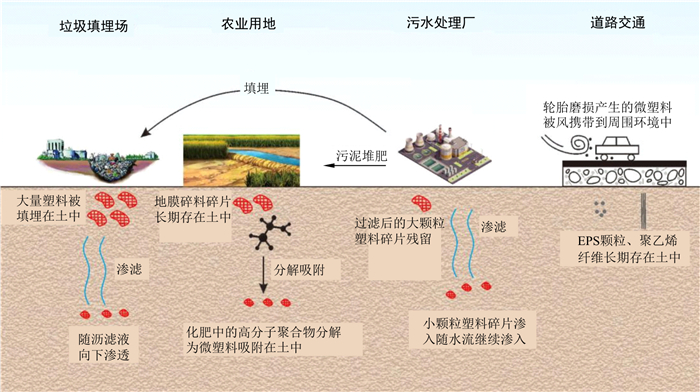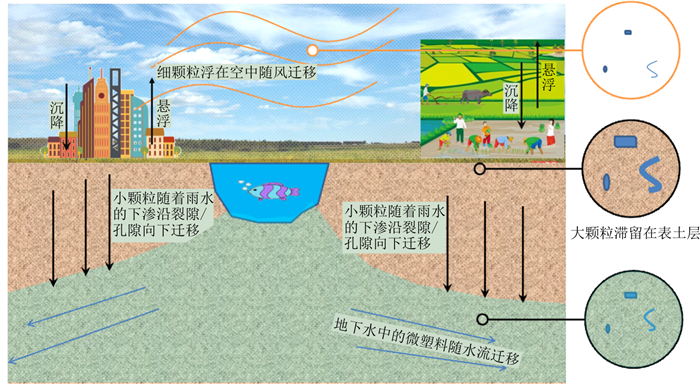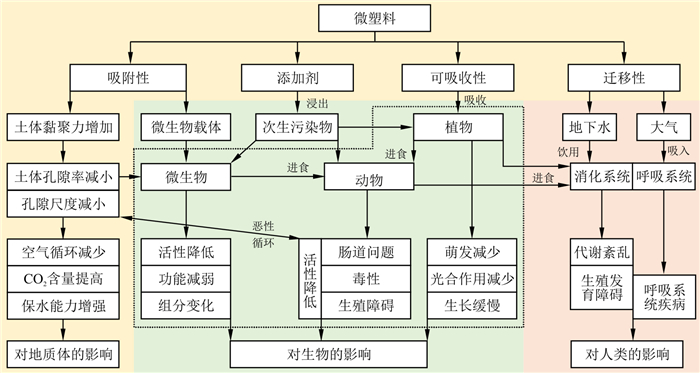Microplastic contamination in terrestrial geoenvironments: Review and outlook
-
摘要:
陆地地质环境中的微塑料污染日渐广泛和严重, 受到科学界的广泛关注, 但研究尚处于起步阶段。对近5年微塑料研究的国际文献进行了综述, 从来源与组成、迁移和环境影响3个方面进行了梳理和总结, 并提出了下一步研究建议。近期研究发现陆地地质环境中的微塑料主要来源于垃圾填埋场、农业面源污染、污水处理系统和交通运输系统, 不同来源的微塑料存在显著差异, 具有时空变异性。微塑料会随土体人为扰动、土内生物活动在土体内迁移, 还可能渗入地下水并借助渗流迁移, 或悬浮到大气中并借助风力迁移, 颗粒越小越容易迁移。微塑料使土体黏聚力增加、孔隙率降低、孔隙尺度减小、空气循环减少、保水能力提高, 微塑料中强水溶性添加剂的渗出会造成地质体次生污染。微塑料对植物生长、动物消化、微生物活性存在不利影响, 会诱发人类能量和脂质代谢紊乱、氧化应激和呼吸系统疾病。微塑料污染地质体修复仍处于起步阶段, 仅在少量室内试验中发现了微生物降解和生物修复的效果。综上, 微塑料污染广泛存在, 且对生物和人类健康带来诸多不利影响。面向未来, 尚需探明微塑料对陆地生态系统中营养传输的影响、微塑料添加剂在地质体中的迁移和降解规律, 研发更高效便捷的微塑料定量检测方法, 制定全球统一的测试和评价标准, 将微塑料检测列入污染土检测项目, 研发高效的微塑料污染地质体修复方法。
Abstract:Significance The increasingly widespread and serious microplastic contamination in terrestrial geoenvironments(CMTG)has received much attention. However, studies on CMTG are still in the initial stage. This paper reviews the international literature on CMTG in the last five years.The sources, composition, migration and environmental impacts of CMTG are summarized, and an outlook is presented.
Progress The results of the study demonstrate that the main sources of CMTG include landfills, agricultural nonpoint sources, sewage treatment systems, and transportation systems.The composition of CMTG presents significant temporal and spatial variability depending on the sources. The migration pathways of CMTG include human disturbance to soil, biological activities in soil, groundwater seepage, and wind transportation of suspended particles. The smaller the particles, the easier they migrate. CMTG has many influences on geological bodies, including increasing cohesion, decreasing porosity and pore size, decreasing air circulation, and increasing water retention capacity. Moreover, secondary pollution of geological bodies may be caused by effusion of the water-soluble additives in CMTG. Adverse effects of CMTG on plant growth, animal digestion and microbial activity have been found. For humans, energy induction, lipid metabolism disorders, oxidative stress and respiratory diseases induced by CMTG are well understood.
Conclusions and outlooks In summary, CMTG is widespread and has many adverse effects on biological and human health. In the future, the effects of CMTG on nutrient transport in terrestrial ecosystems and the migration and degradation of CMTG additives in terrestrial geological bodies should be investigated, efficient and convenient quantitative detection methods for CMTG should be developed, global unified evaluation standards should be established, detection of CMTG should be listed in the detection project of contaminated soils, and efficient remediation methods for microplastic-contaminated geological bodies should be developed.
-
Key words:
- geological body /
- microplastic /
- land /
- contamination /
- migration /
- environment /
- health
-
从服装到食品包装,塑料的使用规模越来越大,尤其是2019年新冠大流行后,为了个人防护和卫生,全球范围内使用一次性塑料进一步大幅增加[1]。塑料最终破碎成微塑料,比表面积大,并具有疏水性,容易吸附重金属、内分泌干扰物、抗生素和有机污染物,形成共同迁移效应[2-3]。微塑料已对很多物种造成了伤害,包括蚯蚓等生态系统服务基本物种[4],对地球环境和生态系统造成了破坏。此外,微塑料还会进入食物、水和空气中,威胁人类健康。因此,微塑料污染已成为重要的研究热点。
迄今为止,对于微塑料含量、类型和影响的研究以海洋环境中的微塑料为重心。Horton等[5]分析认为,进入陆地地质环境中的微塑料量是入海微塑料量的4~23倍,很有必要深入研究陆地地质环境中的微塑料污染(contamination of microplastics in terrestrial geoenvironment,简称CMTG),包括来源、组成、迁移特征和环境影响等。笔者拟对近5年来研究发现的相关知识进行梳理和总结,并提出下一步工作建议,以便对陆地地质环境的微塑料污染研究提供指导价值。
1. 陆地地质环境中微塑料的来源和组成
1.1 陆地地质环境中微塑料的来源
陆地地质环境中的微塑料主要来源于垃圾填埋场、农业面源污染、污水处理系统和交通运输系统,路径如图 1所示。
(1) 垃圾填埋场
城市生产生活垃圾中含有大量塑料,全世界约有一半被送往垃圾填埋场进行集中处理[6]。垃圾填埋场中微塑料含量非常高,每千克普通垃圾中微塑料的含量一般为(62 000±23 000)个[7]。有些垃圾填埋场会填埋污水处理厂的污泥,每千克污泥中微塑料含量一般为4 196~15 385个[8]。垃圾填埋场中的微塑料会向周围的地下水和岩土体迁移[9],尤其是旧的非标准垃圾填埋场,没有设置衬垫、覆盖层和渗滤液收集系统[10],大量微塑料随沥滤液迁移到周围地质环境中[11]。因此,应加强标准化垃圾填埋场建设,做好衬垫隔离系统,防范微塑料进入地质环境中。
(2) 农业面源污染
农田中广泛使用地膜、网子等塑料制品,2017年我国地膜使用量达到了1.866 48×1011[12],服役后大都不进行收集和处理,在耕种时进入陆地地质环境中,经过长期的磨砺和风化转化为微塑料[13]。另外,农业生产中广泛施用缓释肥,其中含有高分子聚合物基的微胶囊,这些高分子聚合物逐渐分解并缓慢释放肥料后,最终以微塑料的形式留在了土壤中[14]。还有一些有机肥是用污水处理厂的污泥堆肥的,如前所述污泥中微塑料含量非常高[8],据此把大量微塑料引入了陆地地质环境中。考虑到微塑料的长远不良影响,应该加强管理,促进农用地膜和网子的回收,进行集中焚烧发电或填埋处理。在农用肥料方面,应研究开发缓释肥用可降解微胶囊,并减少污泥堆肥的应用。
(3) 污水处理系统
污水处理系统包括城市污水处理厂和化粪池等就地处理系统[15],污水中含有的大量塑料会在污水处理时或次生产品处置时进入陆地地质环境中。城市污水中的塑料主要有聚酯纤维、聚乙烯、聚丙烯[16]和塑料微珠[17]。就地处理系统没有隔离系统,微塑料一部分随水渗入地质环境中;一部分随污泥弃置或土地应用进入地质环境中。城市污水处理厂处理中微塑料去除率达到80%以上,在Rasmussen等[18]的定量研究中,微塑料被滤网去除了73.4%,降解了12.7%,进入污泥的为13.6%,出水中仅残留0.35%。关键在于滤网上的塑料和污泥的处理,如果进行焚烧处理就能避免二次污染,如果运往垃圾填埋场或者堆肥,就会进入陆地地质环境中。据估计,欧洲每年有4万~5万t微塑料通过该途径进入陆地地质环境中,北美洲为每年6.3万~43万t[19],澳大利亚为1.9万t[20]。可见,应加强标准化污水处理厂的建设,逐渐消除废旧的污水就地处理系统,对于污水处理厂收集的塑料,可用于焚烧发电,既能切断塑料进入地质环境的通道,还能产生电能。
(4) 交通运输系统
交通运输系统也是陆地地质环境中微塑料的重要来源。①轮胎磨损产生的微塑料[21-22],粒径低至10 μm[23],这些可吸入颗粒物可以在空气中长时间漂浮,并由风携带到周围陆地地质环境中,粗颗粒则被降雨冲刷到周围地质环境中; ②道路材料中人为添加的高分子聚合物,如路面沥青材料[24]、加筋土中的聚乙烯纤维[25]、轻质土中的发泡聚苯乙烯[26-27]和再生轮胎颗粒[28-29]、疏浚淤泥再生路基填料[30]中的微塑料[31]。在它们完成服役后,无法从土体中分离出来[25],对地质环境造成严重的局部微塑料污染。为了减少交通系统进入地质环境中的微塑料,可以通过提高路面平整度减少磨损来实现,而对于掺加塑料的路基,可通过设置外包裹将塑料包裹在现在的局部环境中。
由于陆地地质环境中缺乏紫外光,且温度稳定在低温,微塑料不易风化和降解,能保持相当长的时间,逐渐进入的微塑料会发生累积,产生叠加影响,所以要防微杜渐,采取各种措施减少微塑料污染陆地地质环境。
1.2 陆地地质环境中微塑料的组成
陆地地质环境中的微塑料按照来源可分为原发性微塑料和次发性微塑料[32],原发性微塑料是指成分和颗粒大小与生产时没有变化的微塑料,如个人护理产品中的塑料微珠[33];次发性微塑料是指大块塑料产品经过物理破碎、化学风化形成的微塑料,如合成纺织品衣物破碎形成的微纤维等。按照具体化学成分,微塑料主要有聚酯纤维、聚乙烯和聚丙烯,三者占到微塑料的90%以上[34-35]。按照形态,微塑料主要呈现为纤维状、碎片状(膜状)、球状或颗粒状[36]。本研究收集了近期一些典型场地中微塑料的组成情况,如表 1所示,陆地地质环境中微塑料的组成因来源不同而存在显著差异,有些是传统塑料和可降解塑料的混合物,也会随地点不同而变化,随时间延续而演化,具有时空变异性;当前陆地环境中的可降解塑料含量很少,应该推广可降解塑料,也可以使用草编等替代品减少不可降解塑料的用量。在合成微塑料的缓慢降解过程中,颗粒变小,比表面积增加,含氧官能团增加,对土中微生物、重金属和其他污染物的吸附性也会提高[32]。
表 1 典型陆地地质环境中微塑料的组成情况Table 1. Composition of microplastics in typical terrestrial geological environments场地 城市 粒径/μm 平均浓度 主要成分 主要形状 垃圾填埋场垃圾[7] 中国上海 20~5 000 39 000~85 000粒/kg 聚乙烯 碎片状 长期覆膜农田[37] 中国京津冀 平均2 950 平均29.3粒/kg 主要成分为聚乙烯,占43.7% 碎片状 施用固废堆肥的农田[38] 法国巴黎 0.45~5 000 0.16~1.2 kg/(ha-1·a-1) 未测定 颗粒状 垃圾填埋场渗滤液[35] 中国长三角 100~5 000 0.4~24.6粒/L 聚乙烯和聚丙烯 纤维状和薄膜状,纤维状占60% 地下水[39] 印度佩鲁古迪遗址 0.45~5 000 7~80粒/L 聚苯乙烯和聚丙烯 未观测 尽管陆地地质环境中普遍存在微塑料污染问题,但限于当前分析方法的局限性,微塑料污染并未列入地质环境检测项目,科学研究中标准还是不够统一,工程中更没有量化结果[9, 33],急需研发更高效便捷的土体微塑料定量检测方法,并将微塑料检测列入污染土检测项目。
2. 微塑料在陆地地质环境中的迁移
微塑料进入陆地地质环境后,还会在陆地环境中发生多种迁移,包括土内迁移、随水迁移和随风迁移,如图 2所示。
2.1 微塑料在土体中的迁移
微塑料在土体中的迁移包括水平迁移和垂直迁移,主要受到工程地质与水文地质条件、土体人为扰动、土内生物活动和微塑料形态的影响[40]。工程地质与水文地质条件中最重要的影响因素是孔隙大小和水的丰度。细粒土孔隙尺度小,大部分微塑料的粒度大于孔隙尺寸,就会滞留在地质体上层[36],形成上多下少的分布特征;粗粒土孔隙尺度大,细小的微塑料就可以通过水流或胶体输送到地质体深处;砂质土中的微塑料会发生显著的垂直迁移[41],微塑料颗粒尺寸随迁移距离的增加和干湿循环次数的增加而减小[42]。类似地,富含生物孔隙的土体和龟裂土也具有孔隙大、水流快的特征,会发生类似的微塑料运输[43]。此外,黏粒和胶体的含量、主阳离子、含铁量、有机质含量和pH值等也会对微塑料在土体中的运移产生影响[36]。土体的人为扰动包括耕作和工程建设等,耕作会帮助微塑料进入深层土体,并在整个耕作层内倾向于均匀分布,工程建设会使得微塑料随土体的移位而改变位置。生物活动会促进微塑料的碎裂和尺寸选择性运输,进一步加剧微塑料向深部土体和包气带迁移[44-45]。当然微塑料自身的形态也会影响迁移,颗粒越小越容易迁移,颗粒越大越难于迁移;圆球状最容易迁移,颗粒状次之,纤维状更难,碎片状最难[36]。
2.2 微塑料渗入地下水中并借助渗流迁移
微塑料不断破碎,颗粒越细,进入地下水的可能性就越大。很多研究者发现了垃圾填埋场和农业土壤中的微塑料进入地下水的情况[46-47]。不同地质体的地下水中微塑料的浓度存在数量级的差异,孔隙或裂缝越大,微塑料浓度越高,存在大量空洞的岩溶系统中微塑料的大小和浓度与地表水中相近[48]。微塑料一旦进入地下水,就可以在含水层中大规模运移,尤其是冲积含水层,从1 μm到1 mm的都可以传输[49]。可见,对于微塑料含量高的局部区域,应设置隔水设施,以减少水分的深入和运移,防止微塑料大范围扩散。必要之处是,迄今为止微塑料随地下水迁移的研究还很少[50],且只有5篇文章提供了评估地下水中微塑料的采样方法[46, 48-49, 51-52],还没有统一的地下水中微塑料的采样和量化测定方法,这是当前存在的一个关键瓶颈问题。此外,尚未见微塑料对地下水生态系统、地下水循环的影响研究,需要提前开展研究,以保障全球20亿人依赖的地下水资源充足、安全。
2.3 微塑料悬浮到大气中并借助风力迁移
全球多处大气中发现了微塑料,不仅是城市上空,农村偏远地区也存在,更重要的是大气中的微塑料能够在全球范围内远距离迁移[27]。大气中的微塑料大都来源于地表,如汽车轮胎碎屑[21-23]、施肥污泥中的微塑料等。微塑料类似于其他细颗粒,能够在地表和大气间相互转移,风力较小时大颗粒微塑料就会沉降到地表,风力较大时地表小颗粒微塑料又会重新悬浮到大气中继续迁移,因此借助风力的微塑料迁移最难以预计,也最难以控制。
3. 陆地地质环境中微塑料的环境健康影响
微塑料进入陆地地质环境后,会对陆地环境产生多方位的影响,包括对地质的影响、对生物的影响和对人类的影响,如图 3所示。
3.1 微塑料对地质的影响
微塑料进入地质体后,会引起地质体的变化。Luo等[53]以0.047 μm大小的聚丙烯为例研究了土颗粒与微塑料的吸附力,发现吸附力主要来源于静电作用和疏水作用,吸附力随土体内有机碳或Fe2O3含量的增加而提高,表现为良好的线性正相关关系,吸附力随黏粒含量提高而降低,随pH值的升高而降低,并受zeta电位影响。土颗粒与微塑料的高吸附力使得土体黏聚力增加,土体变得更加紧密,会降低土体的孔隙率和孔隙尺度[54],提高土壤保水能力[55],减少土体中的空气循环,增加土体中的二氧化碳含量[56]。纤维状、片状微塑料还会对土体产生加筋作用,会提高土体的抗剪强度;而圆球状微塑料则会减小土颗粒间的摩擦力,降低土体的抗剪强度。此外,摄入微塑料会降低蚯蚓等动物的活性,也会间接造成土体更加密实,以及土体内养分的减少[57-59]。微塑料对陆地环境的影响,不能只考虑微塑料本身,还要考虑塑料生产过程中添加的增塑剂、紫外线稳定剂等关联化学成分,常见的有邻苯二甲酸盐、双酚A和双酚S,它们的水溶性强,会从微塑料中渗出,造成地质体的次生污染[60]。综上可见,微塑料污染会对农用土地和绿化用地质量造成诸多不利影响,应该想方设法减少进入地质环境中的微塑料。
3.2 微塑料对生物的影响
大量证据表明陆生植物会吸收地质环境中的微塑料[61-62],意大利托斯卡纳垃圾填埋场附近的苔藓中就发现了大量微塑料,距离填埋场越近微塑料浓度越高,临近填埋场附处浓度为79粒/g,距离填埋场200 m处浓度为13粒/g,距离填埋场1 500 m处浓度为7粒/g[63]。植物可以通过静电力等吸附微塑料,也可以将其困在结构转折处,纳米塑料甚至能够穿过细胞膜进入植物细胞中,并继而产生毒理作用,对植物的萌发、光合作用和生长造成不利影响[64-67]。
蚯蚓等腐食动物在进食时会顺带将微塑料吞入[44, 68-69],由于微塑料不易被消化,容易造成动物的肠道问题、氧化应激损伤、组织病理学变化和生殖障碍[56-57, 59]。微塑料中的添加剂也会对动物造成伤害,如双酚A对甲壳类动物存在急性毒性和慢性毒性,特别是等足类动物最敏感[70]。如前所述,微塑料使得土体孔隙率下降,也会限制土体内中型动物的运动,对其健康造成伤害[71]。
微生物则会在微塑料表面定居,形成生物膜,在污泥微塑料上发现了鲍曼不动杆菌、金雀花菌、铜绿假单胞菌、大肠埃希菌、炭疽杆菌、黏质沙雷氏菌和嗜水气单胞菌[72],但是微塑料降低了微生物的功能和活性[73]。研究表明聚对苯二甲酸乙二醇酯和聚乙烯微塑料引起了微生物的组成变化,聚乙烯使得微生物的二氧化碳排放量增加了7~8倍[20]。
综上可见,陆地地质环境中的微塑料对植物、动物和微生物存在广泛的不良影响,降低其生物活性,甚至引起微生物的变异,对整个生态系统必将产生系统性影响,当前很少见生态系统层次的研究,也将是未来研究的发展方向。
3.3 微塑料对人类的影响
陆地地质环境中的微塑料及其添加剂进入饮用水或者食物链后,则会随饮食进入人体[74-76],Senathirajah等[77]估计每人每天可能摄入多达10万个微塑料颗粒,为进食量的0.1%~5%。这也从人体粪便和血液中发现的微塑料得到了证实[78-80]。一旦进入胃肠道,微塑料可能会转移到其他生理器官,孕期妇女的胎盘、母体、胎儿中都发现了微塑料[81]。微塑料在肝脏和肾脏中的累积会导致能量和脂质代谢紊乱,以及氧化应激[82]。邻苯二甲酸盐、双酚A和双酚S等添加剂是内分泌干扰物,会造成生殖和发育障碍[83-84]。除了微塑料自身以外,微塑料有助于植物吸收重金属,对人类健康带来间接威胁。陆地地质环境中的微塑料在风力较大时悬浮到大气中,会随人类呼吸进入人体,在肺组织中发现了合成纤维[85],特别难于清除,严重时就会造成呼吸系统疾病[86-87]。为了人类健康,必须进一步加强对塑料生产、使用和废弃的管理,减少地质环境中的微塑料来源,切断微塑料大规模扩散的渠道,另一方面也要强化微塑料诱发疾病的治疗技术研究。
4. 总结与展望
4.1 结论
(1) 陆地地质环境中的微塑料主要来源于垃圾填埋场、农业面源污染、污水处理系统和交通运输系统。主要成分是聚酯纤维、聚乙烯和聚丙烯,以及附含的邻苯二甲酸盐、双酚A和双酚S等添加剂,具体组成因来源不同而存在显著差异,也会随地点不同而变化、随时间延续而演化,具有时空变异性。
(2) 微塑料在土体中的迁移主要受到工程地质与水文地质条件、土体人为扰动、土内生物活动和微塑料形态的影响,颗粒越小越容易迁移,圆球状的最容易迁移,颗粒状的次之,纤维状的更难,碎片状的最难。微塑料还可能渗入地下水中并借助渗流迁移,或悬浮到大气中并借助风力迁移。
(3) 土颗粒与微塑料的高吸附力使得土体黏聚力增加,土体变得更加紧密,孔隙率降低,孔隙尺度减小,空气循环减少,保水能力提高,二氧化碳含量增加。纤维状、片状微塑料会对土体产生加筋作用,提高土体强度;圆球状微塑料会减小土颗粒间的摩擦力,降低土体抗剪强度。此外,微塑料中强水溶性添加剂的渗出会造成地质体的次生污染。
(4) 微塑料对植物的萌发、光合作用和生长存在不利影响,会造成动物的肠道问题、氧化应激损伤、组织病理学变化和生殖障碍,会降低微生物的功能和活性;微塑料在人体肝脏和肾脏中的累积会导致能量和脂质代谢紊乱、氧化应激损伤,添加剂会造成生殖和发育障碍,吸入的微塑料可诱发呼吸系统疾病。
4.2 存在的问题与展望
(1) 限于当前分析方法的局限性,微塑料污染并未列入环境地质检测项目,也缺乏定量化评价标准,这是当前面临的最主要瓶颈。因此,急需研发更高效便捷的微塑料定量检测方法,制定全球统一的测试和评价标准,包括采样方法、测定方法、污染性评价,并将微塑料检测列入污染土检测项目。
(2) 微塑料污染地质体修复仍处于起步阶段,仅在少量室内试验中发现了微生物降解和生物修复的效果,尚需要对更多塑料污染物、更多降解微生物开展研究,尚需在更大尺度上开展研究与应用实践,开发出有效的微塑料污染地质体修复方法。
(3) 还有一些重要节点需要开展工作,包括化粪池等就地处理场中微塑料的去除率和去向、微塑料对陆地生态系统中营养传输的影响、微塑料添加剂在地质体中的迁移和降解规律、路基路面中人为添加塑料的环境危害和应对方法。
(所有作者声明不存在利益冲突) -
表 1 典型陆地地质环境中微塑料的组成情况
Table 1. Composition of microplastics in typical terrestrial geological environments
场地 城市 粒径/μm 平均浓度 主要成分 主要形状 垃圾填埋场垃圾[7] 中国上海 20~5 000 39 000~85 000粒/kg 聚乙烯 碎片状 长期覆膜农田[37] 中国京津冀 平均2 950 平均29.3粒/kg 主要成分为聚乙烯,占43.7% 碎片状 施用固废堆肥的农田[38] 法国巴黎 0.45~5 000 0.16~1.2 kg/(ha-1·a-1) 未测定 颗粒状 垃圾填埋场渗滤液[35] 中国长三角 100~5 000 0.4~24.6粒/L 聚乙烯和聚丙烯 纤维状和薄膜状,纤维状占60% 地下水[39] 印度佩鲁古迪遗址 0.45~5 000 7~80粒/L 聚苯乙烯和聚丙烯 未观测 -
[1] Vaverková M D, Paleologos E K, Dominijanni A, et al. Municipal solid waste management under COVID-19: Challenges and recommendations[J]. Environmental Geotechnics, 2021, 8(3): 217-232. doi: 10.1680/jenge.20.00082 [2] Qi Y, Ossowicki A, Yang X, et al. Effects of plastic mulch film residues on wheat rhizosphere and soil properties[J]. Journal of Hazardous Materials, 2020, 387: 121711. doi: 10.1016/j.jhazmat.2019.121711 [3] Su Y L, Zhang Z J, Zhu J D, et al. Microplastics act as vectors for antibiotic resistance genes in landfill leachate: The enhanced roles of the long-term aging process[J]. Environmental Pollution, 2021, 270: 116278. doi: 10.1016/j.envpol.2020.116278 [4] Lwanga E H, Gertsen H, Gooren H, et al. Microplastics in the terrestrial ecosystem: implications for Lumbricus terrestris(Oligochaeta, Lumbricidae)[J]. Environmental Science & Technology, 2016, 50(5): 2685-2691. [5] Horton A A, Walton A, Spurgeon D J, et al. Microplastics in freshwater and terrestrial environments: Evaluating the current understanding to identify the knowledge gaps and future research priorities[J]. Science of the Total Environment, 2017, 586: 127-141. doi: 10.1016/j.scitotenv.2017.01.190 [6] 梁晓霏. "净零"排放趋势下塑料循环经济前景分析[J]. 石油化工技术与经济, 2022, 38(2): 1-8. https://www.cnki.com.cn/Article/CJFDTOTAL-SYHA202202001.htmLiang X F. Analysis of recycling economy prospects of plastics under the trend of "net zero emission"[J]. Petrochemical Technology and Economy, 2022, 38(2): 1-8(in Chinese with English abstract). https://www.cnki.com.cn/Article/CJFDTOTAL-SYHA202202001.htm [7] Su Y, Zhang Z, Wu D, et al. Occurrence of microplastics in landfill systems and their fate with landfill age[J]. Water Research, 2019, 164: 114968. doi: 10.1016/j.watres.2019.114968 [8] Mahon A M, O'Connell B, Healy M G, et al. Microplastics in sewage sludge: Effects of treatment[J]. Environmental Science & Technology, 2017, 51(2): 810-818. [9] O'Kelly B C, El-Zein A, Liu X, et al. Microplastics in soils: An environmental geotechnics perspective[J]. Environmental Geotechnics, 2021, 8(8): 586-618. doi: 10.1680/jenge.20.00179 [10] Chandana N, Goli V S N S, Mohammad A, et al. Characterization and utilization of landfill-mined-soil-like-fractions(LFMSF) for sustainable development: A critical appraisal[J]. Waste and Biomass Valorization, 2021, 12(2): 641-662. doi: 10.1007/s12649-020-01052-y [11] Guerranti C, Martellini T, Perra G, et al. Microplastics in cosmetics: Environmental issues and needs for global bans[J]. Environmental Toxicology and Pharmacology, 2019, 68: 75-79. doi: 10.1016/j.etap.2019.03.007 [12] 马兆嵘, 刘有胜, 张芊芊, 等. 农用塑料薄膜使用现状与环境污染分析[J]. 生态毒理学报, 2020, 15(4): 21-32. https://www.cnki.com.cn/Article/CJFDTOTAL-STDL202004003.htmMa Z R, Liu Y S, Zhang Q Q, et al. The usage and environmental pollution of agricultural plastic film[J]. Asian Journal of EcoToxicology, 2020, 15(4): 21-32(in Chinese with English abstract). https://www.cnki.com.cn/Article/CJFDTOTAL-STDL202004003.htm [13] Steinmetz Z, Wollmann C, Schaefer M, et al. Plastic mulching in agriculture: Trading short-term agronomic benefits for long-term soil degradation?[J]. Science of the Total Environment, 2016, 550: 690-705. doi: 10.1016/j.scitotenv.2016.01.153 [14] Katsumi N, Kusube T, Nagao S, et al. Accumulation of microcapsules derived from coated fertilizer in paddy fields[J]. Chemosphere, 2021, 267: 129185. doi: 10.1016/j.chemosphere.2020.129185 [15] 谢先军, 刘红杏, 高爽, 等. 典型纳污坑塘周边地下水污染来源识别及其健康风险评估[J]. 地质科技通报, 2020, 39(1): 34-42. doi: 10.19509/j.cnki.dzkq.2020.0104Xie X J, Liu H X, Gao S, et al. Groundwater pollution sources identification and health risk assessment around typical drainage pits[J]. Bulletin of Geological Science and Technology, 2020, 39(1): 34-42(in Chinese with English abstract). doi: 10.19509/j.cnki.dzkq.2020.0104 [16] Ruffell H, Pantos O, Northcott G, et al. Wastewater treatment plant effluents in New Zealand are a significant source of microplastics to the environment[J]. New Zealand Journal of Marine and Freshwater Research, 2023, 57(3): 336-352. doi: 10.1080/00288330.2021.1988647 [17] Conley K, Clum A, Deepe J, et al. Wastewater treatment plants as a source of microplastics to an urban estuary: Removal efficiencies and loading per capita over one year[J]. Water Research X, 2019, 3: 100030. doi: 10.1016/j.wroa.2019.100030 [18] Rasmussen L A, Iordachescu L, Tumlin S, et al. A complete mass balance for plastics in a wastewater treatment plant - macroplastics contributes more than microplastics[J]. Water Research, 2021, 201: 117307. doi: 10.1016/j.watres.2021.117307 [19] Nizzetto L, Futter M, Langaas S. Are agricultural soils dumps for microplastics of urban origin?[J]. Environmental Science and Technology, 2016, 50(20): 10777-10779. doi: 10.1021/acs.est.6b04140 [20] Ng E L, Lin S Y, Dungan A M, et al. Microplastic pollution alters forest soil microbiome[J]. Journal of Hazardous Materials, 2021, 409: 124606. doi: 10.1016/j.jhazmat.2020.124606 [21] Evangeliou N, Grythe H, Klimont Z, et al. Atmospheric transport is a major pathway of microplastics to remote regions[J]. Nature Communications, 2020, 11(1): 3381. doi: 10.1038/s41467-020-17201-9 [22] Schwarz A E, Ligthart T N, Boukris E, et al. Sources, transport, and accumulation of different types of plastic litter in aquatic environments: A review study[J]. Marine Pollution Bulletin, 2019, 143: 92-100. doi: 10.1016/j.marpolbul.2019.04.029 [23] Kole P J, Löhr A J, van Belleghem F G A J, et al. Wear and tear of tyres: A stealthy source of microplastics in the environment[J]. International Journal of Environmental Research and Public Health, 2017, 14(10): 1265. doi: 10.3390/ijerph14101265 [24] Rødland E S, Samanipour S, Rauert C, et al. A novel method for the quantification of tire and polymer-modified bitumen particles in environmental samples by pyrolysis gas chromatography mass spectroscopy[J]. Journal of Hazardous Materials, 2022, 423: 127092. doi: 10.1016/j.jhazmat.2021.127092 [25] O'Kelly B C, Soltani A. Discussion of "Behaviour of a foam mixture as a lightweight construction material"[Int. J. of Geosynth. and Ground Eng. (2021) 7(3), 51][J]. International Journal of Geosynthetics and Ground Engineering, 2018, 2022, 8(2): 30. [26] Li M, Wen K, Li L, et al. Mechanical properties of expanded polystyrene beads stabilized lightweight soil[J]. Geomechanics and Engineering, 2017, 13(3): 459-474. [27] Zhang Y, Gao T, Kang S, et al. Importance of atmospheric transport for microplastics deposited in remote areas[J]. Environmental Pollution, 2019, 254: 112953. doi: 10.1016/j.envpol.2019.07.121 [28] Zhou Y, Li M, He Q, et al. Deformation and damping characteristics of lightweight clay-EPS soil under cyclic loading[J]. Advances in Civil Engineering, 2018: 8093719. [29] Zhou Y, Li M, Wen K, et al. Stress-strain behaviour of reinforced dredged sediment and expanded polystyrenes mixture under cyclic loading[J]. Geomechanics and Engineering, 2019, 17(6): 507-513. [30] Monkul M M, Özhan H O. Microplastic contamination in soils: A review from geotechnical engineering view[J]. Polymers, 2021, 13(23): 4129. doi: 10.3390/polym13234129 [31] Ji X, Ma Y, Zeng G, et al. Transport and fate of microplastics from riverine sediment dredge piles: Implications for disposal[J]. Journal of Hazardous Materials, 2021, 404: 124132. doi: 10.1016/j.jhazmat.2020.124132 [32] 王焰新, 甘义群, 邓娅敏, 等. 海岸带海陆交互作用过程及其生态环境效应研究进展[J]. 地质科技通报, 2020, 39(1): 1-10. doi: 10.19509/j.cnki.dzkq.2020.0101Wang Y X, Gan Y Q, Deng Y M, et al. Coastal zone sea-land interaction process and its ecological effect research progress[J]. Bulletin of Geological Science and Technology, 2020, 39(1): 1-10(in Chinese with English abstract). doi: 10.19509/j.cnki.dzkq.2020.0101 [33] Golwala H, Zhang X, Iskander S M, et al. Solid waste: An overlooked source of microplastics to the environment[J]. Science of the Total Environment, 2021, 769: 144581. doi: 10.1016/j.scitotenv.2020.144581 [34] Goli V S N S, Paleologos E K, Farid A, et al. Extraction, characterisation and remediation of microplastics from organic solid matrices[J]. Environmental Geotechnics, 2022: 2100072. [35] He P, Chen L, Shao L, et al. Municipal solid waste(MSW)landfill: A source of microplastics?: Evidence of microplastics in landfill leachate[J]. Water Research, 2019, 159: 38-45. doi: 10.1016/j.watres.2019.04.060 [36] Ren Z, Gui X, Xu X, et al. Microplastics in the soil-groundwater environment: Aging, migration, and co-transport of contaminants: A critical review[J]. Journal of Hazardous Materials, 2021, 419: 126455. doi: 10.1016/j.jhazmat.2021.126455 [37] Li R, Liu Y, Sheng Y, et al. Effect of prothioconazole on the degradation of microplastics derived from mulching plastic film: Apparent change and interaction with heavy metals in soil[J]. Environmental Pollution, 2020, 260: 113988. doi: 10.1016/j.envpol.2020.113988 [38] Watteau F, Dignac M F, Bouchard A, et al. Microplastics detection in soil amended with municipal solid waste composts as revealed by transmission electron microscopy and pyrolysis/GC/MS[J]. Frontiers in Sustainable Food Systems, 2018, 2: 81. doi: 10.3389/fsufs.2018.00081 [39] Manikanda Bharath K, Usha N, Vaikunth R, et al. Spatial distribution of microplastic concentration around landfill sites and its potential risk on groundwater[J]. Chemosphere, 2021, 277: 130263. doi: 10.1016/j.chemosphere.2021.130263 [40] Rillig M C, Lehmann A, de Souza Machado A A, et al. Microplastic effects on plants[J]. New Phytologist, 2019, 223(3): 1066-1070. doi: 10.1111/nph.15794 [41] 叶芯瑶, 吴鸣, 胡晓农, 等. 纳米塑料颗粒在饱和多孔介质中的迁移规律[J]. 地质科技通报, 2022, 41(4): 225-233. doi: 10.19509/j.cnki.dzkq.2021.0064Ye X Y, Wu M, Hu X N, et al. Nano plastic particles migration patterns in saturated porous media[J]. Bulletin of Geological Science and Technology, 2022, 41(4): 225-233(in Chinese with English abstract). doi: 10.19509/j.cnki.dzkq.2021.0064 [42] O'Connor D, Pan S, Shen Z, et al. Microplastics undergo accelerated vertical migration in sand soil due to small size and wet-dry cycles[J]. Environmental Pollution, 2019, 249: 527-534. doi: 10.1016/j.envpol.2019.03.092 [43] Bläsing M, Amelung W. Plastics in soil: Analytical methods and possible sources[J]. Science of the Total Environment, 2018, 612: 422-435. doi: 10.1016/j.scitotenv.2017.08.086 [44] Huerta L E, Gertsen H, Gooren H, et al. Incorporation of microplastics from litter into burrows of Lumbricus terrestris[J]. Environmental Pollution, 2017, 220: 523-531. doi: 10.1016/j.envpol.2016.09.096 [45] Zhu D, Bi Q F, Xiang Q, et al. Trophic predator-prey relationships promote transport of microplastics compared with the single Hypoaspis aculeifer and Folsomia candida[J]. Environmental Pollution, 2018, 235: 150-154. doi: 10.1016/j.envpol.2017.12.058 [46] Samandra S, Johnston J M, Jaeger J E, et al. Microplastic contamination of an unconfined groundwater aquifer in Victoria, Australia[J]. Science of the Total Environment, 2022, 802: 149727. doi: 10.1016/j.scitotenv.2021.149727 [47] Zhang X, Chen Y, Li X, et al. Size/shape-dependent migration of microplastics in agricultural soil under simulative and natural rainfall[J]. Science of the Total Environment, 2022, 815: 152507. doi: 10.1016/j.scitotenv.2021.152507 [48] Panno S V, Kelly W R, Scott J, et al. Microplastic contamination in karst groundwater systems[J]. Groundwater, 2019, 57(2): 189-196. doi: 10.1111/gwat.12862 [49] Goeppert N, Goldscheider N. Experimental field evidence for transport of microplastic tracers over large distances in an alluvial aquifer[J]. Journal of Hazardous Materials, 2021, 408: 124844. doi: 10.1016/j.jhazmat.2020.124844 [50] Viaroli S, Lancia M, Re V. Microplastics contamination of groundwater: Current evidence and future perspectives. A review[J]. Science of the Total Environment, 2022, 824: 153851. doi: 10.1016/j.scitotenv.2022.153851 [51] Johnson A C, Ball H, Cross R, et al. Identification and quantification of microplastics in potable water and their sources within water treatment works in England and Wales[J]. Environmental Science and Technology, 2020, 54(19): 12326-12334. doi: 10.1021/acs.est.0c03211 [52] Selvam S, Jesuraja K, Venkatramanan S, et al. Hazardous microplastic characteristics and its role as a vector of heavy metal in groundwater and surface water of coastal South India[J]. Journal of Hazardous Materials, 2021, 402: 123786. doi: 10.1016/j.jhazmat.2020.123786 [53] Luo Y, Zhang Y, Xu Y, et al. Distribution characteristics and mechanism of microplastics mediated by soil physicochemical properties[J]. Science of the Total Environment, 2020, 726: 138389. doi: 10.1016/j.scitotenv.2020.138389 [54] Koskei K, Munyasya A N, Wang Y B, et al. Effects of increased plastic film residues on soil properties and crop productivity in agro-ecosystem[J]. Journal of Hazardous Materials, 2021, 414: 125521. doi: 10.1016/j.jhazmat.2021.125521 [55] Machado A A D, Lau C W, Kloas W, et al. Microplastics can change soil properties and affect plant performance[J]. Environmental Science & Technology, 2019, 53(10): 6044-6052. [56] Cuello J P, Hwang H Y, Gutierrez J, et al. Impact of plastic film mulching on increasing greenhouse gas emissions in temperate upland soil during maize cultivation[J]. Applied Soil Ecology, 2015, 91: 48-57. doi: 10.1016/j.apsoil.2015.02.007 [57] Jiang X, Chang Y, Zhang T, et al. Toxicological effects of polystyrene microplastics on earthworm(Eisenia fetida)[J]. Environmental Pollution, 2020, 259: 113896. doi: 10.1016/j.envpol.2019.113896 [58] Kwak J I, An Y J. Microplastic digestion generates fragmented nanoplastics in soils and damages earthworm spermatogenesis and coelomocyte viability[J]. Journal of Hazardous Materials, 2021, 402: 124034. doi: 10.1016/j.jhazmat.2020.124034 [59] Lackmann C, Velki M, Šimiĉ A, et al. Two types of microplastics(polystyrene-HBCD and car tire abrasion) affect oxidative stress-related biomarkers in earthworm Eisenia andrei in a time-dependent manner[J]. Environment International, 2022, 163: 107190. doi: 10.1016/j.envint.2022.107190 [60] Al-Lihaibi S, Al-Mehmadi A, Alarif W M, et al. Microplastics in sediments and fish from the Red Sea coast at Jeddah(Saudi Arabia)[J]. Environmental Chemistry, 2019, 16(8): 641-650. doi: 10.1071/EN19113 [61] Bosker T, Bouwman L J, Brun N R, et al. Microplastics accumulate on pores in seed capsule and delay germination and root growth of the terrestrial vascular plant Lepidium sativum[J]. Chemosphere, 2019, 226: 774-781. doi: 10.1016/j.chemosphere.2019.03.163 [62] Li Z, Li Q, Li R, et al. The distribution and impact of polystyrene nanoplastics on cucumber plants[J]. Environmental Science and Pollution Research, 2021, 28(13): 16042-16053. doi: 10.1007/s11356-020-11702-2 [63] Loppi S, Roblin B, Paoli L, et al. Accumulation of airborne microplastics in lichens from a landfill dumping site(Italy)[J]. Scientific Reports, 2021, 11: 4564. doi: 10.1038/s41598-021-84251-4 [64] Azeem I, Adeel M, Ahmad M A, et al. Uptake and accumulation of nano/microplastics in plants: A critical review[J]. Nanomaterials, 2021, 11(11): 2935. doi: 10.3390/nano11112935 [65] Gao H, Yan C, Liu Q, et al. Effects of plastic mulching and plastic residue on agricultural production: a meta-analysis[J]. Science of the Total Environment, 2019, 651: 484-492. doi: 10.1016/j.scitotenv.2018.09.105 [66] Luo Y M, Li L Z, Feng Y D, et al. Quantitative tracing of uptake and transport of submicrometre plastics in crop plants using lanthanide chelates as a dual-functional tracer[J]. Nature Nanotechnology, 2022, 17(4): 424-431. doi: 10.1038/s41565-021-01063-3 [67] Mateos-Cárdenas A, van Pelt F N A M, O'Halloran J, et al. Adsorption, uptake and toxicity of micro- and nanoplastics: Effects on terrestrial plants and aquatic macrophytes[J]. Environmental Pollution, 2021, 284: 117183. doi: 10.1016/j.envpol.2021.117183 [68] Ashwood F, Butt K R, Doick K J, et al. Investigating tree foliar preference by the earthworms Aporrectodea longa and Allolobophora chlorotica in reclaimed and loam soil[J]. Applied Soil Ecology, 2017, 110: 109-117. doi: 10.1016/j.apsoil.2016.10.007 [69] Guo J J, Huang X P, Xiang L, et al. Source, migration and toxicology of microplastics in soil[J]. Environment International, 2020, 137: 105263. doi: 10.1016/j.envint.2019.105263 [70] Gerhardt A. Plastic additive Bisphenol A: Toxicity in surface- and groundwater crustaceans[J]. Journal of Toxicology and Risk Assessment, 2019, 5(1): 017. [71] Kim S W, An Y J. Soil microplastics inhibit the movement of springtail species[J]. Environment International, 2019, 126: 699-706. doi: 10.1016/j.envint.2019.02.067 [72] Prata J C. Airborne microplastics: Consequences to human health?[J]. Environmental Pollution, 2018, 234: 115-126. doi: 10.1016/j.envpol.2017.11.043 [73] Zhang M, Zhao Y, Qin X, et al. Microplastics from mulching film is a distinct habitat for bacteria in farmland soil[J]. Science of the Total Environment, 2019, 688: 470-478. doi: 10.1016/j.scitotenv.2019.06.108 [74] Daniel D B, Ashraf P M, Thomas S N. Microplastics in the edible and inedible tissues of pelagic fishes sold for human consumption in Kerala, India[J]. Environmental Pollution, 2020, 266: 115365. doi: 10.1016/j.envpol.2020.115365 [75] Kedzierski M, Lechat B, Sire O, et al. Microplastic contamination of packaged meat: Occurrence and associated risks[J]. Food Packaging and Shelf Life, 2020, 24: 100489. doi: 10.1016/j.fpsl.2020.100489 [76] 刘伟, 段佳文, 赵瑞超, 等. 宜昌长江南岸岩溶地下水中水生动物群落分布特征及其环境响应[J]. 地质科技通报, 2022, 41(5): 273-282. doi: 10.19509/j.cnki.dzkq.2022.0218Liu W, Duan J W, Zhao R C, et al. Distribution characteristics and environmental response of aquatic animal communities in karst groundwater on the south bank of Yichang Yangtze River[J]. Bulletin of Geological Science and Technology, 2022, 41(5): 273-282(in Chinese with English abstract). doi: 10.19509/j.cnki.dzkq.2022.0218 [77] Senathirajah K, Attwood S, Bhagwat G, et al. Estimation of the mass of microplastics ingested: A pivotal first step towards human health risk assessment[J]. Journal of Hazardous Materials, 2021, 404: 124004. doi: 10.1016/j.jhazmat.2020.124004 [78] Leslie H A, van Velzen M J M, Brandsma S H, et al. Discovery and quantification of plastic particle pollution in human blood[J]. Environmental International, 2022, 163: 107199. doi: 10.1016/j.envint.2022.107199 [79] Mohamed Nor N H, Kooi M, Diepens N J, et al. Lifetime accumulation of microplastic in children and adults[J]. Environmental Science & Technology, 2021, 55(8): 5084-5096. [80] Schwabl P, Köppel S, Königshofer P, et al. Detection of various microplastics in human stool: A prospective case series[J]. Annals of Internal Medicine, 2019, 171(7): 453-457. doi: 10.7326/M19-0618 [81] Ragusa A, Svelato A, Santacroce C, et al. Plasticenta: First evidence of microplastics in human placenta[J]. Environment International, 2021, 146: 106274. doi: 10.1016/j.envint.2020.106274 [82] Deng Y, Zhang Y. Response to Uptake of microplastics and related health effects: A critical discussion of Deng et al., Scientific reports 7: 46687, 2017[J]. Archives of Toxicology, 2019, 93: 213-215. [83] Mishra S, Rath C C, Das A P. Marine microfiber pollution: A review on present status and future challenges[J]. Marine Pollution Bulletin, 2019, 140: 188-197. doi: 10.1016/j.marpolbul.2019.01.039 [84] Ribeiro F, O'Brien J W, Galloway T, et al. Accumulation and fate of nano- and micro-plastics and associated contaminants in organisms[J]. TrAC Trends in Analytical Chemistry, 2019, 111: 139-147. doi: 10.1016/j.trac.2018.12.010 [85] Enyoh C E, Verla A W, Verla E N, et al. Airborne microplastics: a review study on method for analysis, occurrence, movement and risks[J]. Environmental Monitoring and Assessment, 2019, 191: 668. doi: 10.1007/s10661-019-7842-0 [86] Goli V S N S, Mohammad A, Singh D N. Application of municipal plastic waste as a manmade neo-construction material: Issues & wayforward[J]. Resources, Conservation and Recycling, 2020, 161: 105008. doi: 10.1016/j.resconrec.2020.105008 [87] Knobloch E, Ruffell H, Aves A, et al. Comparison of deposition sampling methods to collect airborne microplastics in Christchurch, New Zealand[J]. Water, Air, and Soil Pollution, 2021, 232(4): 133. doi: 10.1007/s11270-021-05080-9 -






 下载:
下载:



 下载:
下载:








